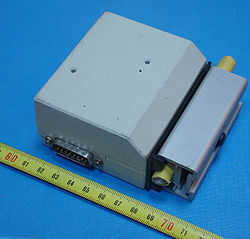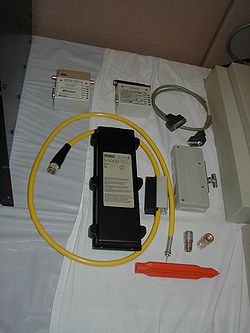
10BASE5
Encyclopedia


Ethernet
Ethernet is a family of computer networking technologies for local area networks commercially introduced in 1980. Standardized in IEEE 802.3, Ethernet has largely replaced competing wired LAN technologies....
.
For its physical layer
Ethernet physical layer
The Ethernet physical layer is the physical layer component of the Ethernet family of computer network standards.The Ethernet physical layer evolved over a considerable time span and encompasses quite a few physical media interfaces and several magnitudes of speed...
it used cable similar to RG-8/U coaxial cable
Coaxial cable
Coaxial cable, or coax, has an inner conductor surrounded by a flexible, tubular insulating layer, surrounded by a tubular conducting shield. The term coaxial comes from the inner conductor and the outer shield sharing the same geometric axis...
but with extra braided shielding. This is a stiff, 0.375 inch (0.9525 cm) diameter cable with an impedance of 50 ohms (Ω), a solid center conductor, a foam insulating filler, a shielding braid, and an outer jacket. The outer sheath was often yellow-to-orange/brown foam fluorinated ethylene propylene
Fluorinated ethylene propylene
Fluorinated ethylene propylene or FEP is a copolymer of hexafluoropropylene and tetrafluoroethylene. It differs from the PTFE resins in that it is melt-processible using conventional injection molding and screw extrusion techniques. Fluorinated ethylene propylene was invented by DuPont and is sold...
(for fire resistance) so it often is called "yellow cable", "orange hose", or sometimes humorously "frozen yellow garden hose".
10BASE5 has been superseded due to the immense demand for high speed networking, and the low cost of Category 5
Category 5 cable
Category 5 cable is a twisted pair cable for carrying signals. This type of cable is used in structured cabling for computer networks such as Ethernet. It is also used to carry other signals such as telephony and video. The cable is commonly connected using punch down blocks and modular connectors...
cable. Both 10BASE2
10BASE2
10BASE2 is a variant of Ethernet that uses thin coaxial cable , terminated with BNC connectors...
and 10BASE5 became obsolete after the introduction of Ethernet over twisted pair
Ethernet over twisted pair
Ethernet over twisted pair technologies use twisted-pair cables for the physical layer of an Ethernet computer network. Other Ethernet cable standards employ coaxial cable or optical fiber. Early versions developed in the 1980s included StarLAN followed by 10BASE-T. By the 1990s, fast, inexpensive...
.
Name origination
The name 10BASE5 is derived from several characteristics of the physical medium. The 10 refers to its transmission speed of 10 Mbit/s. The BASE is short for basebandBaseband
In telecommunications and signal processing, baseband is an adjective that describes signals and systems whose range of frequencies is measured from close to 0 hertz to a cut-off frequency, a maximum bandwidth or highest signal frequency; it is sometimes used as a noun for a band of frequencies...
signalling as opposed to broadband
Broadband
The term broadband refers to a telecommunications signal or device of greater bandwidth, in some sense, than another standard or usual signal or device . Different criteria for "broad" have been applied in different contexts and at different times...
, and the 5 stands for the maximum segment length of 500 metres (1,640.4 ft).
Network design
10BASE5 coax cables had a maximum length of 500 meters (1,640 ft). The maximum number of nodes that can be connected to a 10BASE5 segment is 100. Transceivers may be installed only at precise 2.5-metre intervals. This distance was chosen to not correspond to the wavelength of the signal; this ensures that the reflections from multiple taps are not in phase. These suitable points are marked on the cable with black bands. The cable must be one linear run; T-connections are not allowed.As is the case with most other high-speed buses, segments must be terminated
Electrical termination
Electrical termination of a signal involves providing a terminator at the end of a wire or cable to prevent an RF signal from being reflected back from the end, causing interference...
with a resistor
Resistor
A linear resistor is a linear, passive two-terminal electrical component that implements electrical resistance as a circuit element.The current through a resistor is in direct proportion to the voltage across the resistor's terminals. Thus, the ratio of the voltage applied across a resistor's...
at each end. For coaxial-cable-based Ethernet, each end of the cable has a 50 ohm (Ω) resistor attached. Typically this resistor is built into a male N connector
N connector
The N connector is a threaded RF connector used to join coaxial cables. It was one of the first connectors capable of carrying microwave-frequency signals, and was invented in the 1940s by Paul Neill of Bell Labs, after whom the connector is named.-Design:Originally, the connector was designed to...
and attached to the end of the cable just past the last device. If termination is missing, or if there is a break in the cable, the AC
Alternating current
In alternating current the movement of electric charge periodically reverses direction. In direct current , the flow of electric charge is only in one direction....
signal on the bus is reflected, rather than dissipated when it reaches the end. This reflected signal is indistinguishable from a collision, and so no communication is possible.
Transceiver
Transceiver
A transceiver is a device comprising both a transmitter and a receiver which are combined and share common circuitry or a single housing. When no circuitry is common between transmit and receive functions, the device is a transmitter-receiver. The term originated in the early 1920s...
s can be connected to cable segments with N connector
N connector
The N connector is a threaded RF connector used to join coaxial cables. It was one of the first connectors capable of carrying microwave-frequency signals, and was invented in the 1940s by Paul Neill of Bell Labs, after whom the connector is named.-Design:Originally, the connector was designed to...
s, or via a vampire tap
Vampire tap
A vampire tap is a device for physically connecting a station to a network that uses 10BASE5 cabling...
, which allows new node
Node (networking)
In communication networks, a node is a connection point, either a redistribution point or a communication endpoint . The definition of a node depends on the network and protocol layer referred to...
s to be added while existing connections are live. A vampire tap clamps onto the cable, forcing a spike to pierce through the outer shielding to contact the inner conductor while other spikes bite into the outer braided shield. Care must be taken to keep the outer shield from touching the spike; installation kits include a "coring tool" to drill through the outer layers and a "braid pick" to clear stray pieces of the outer shield.

